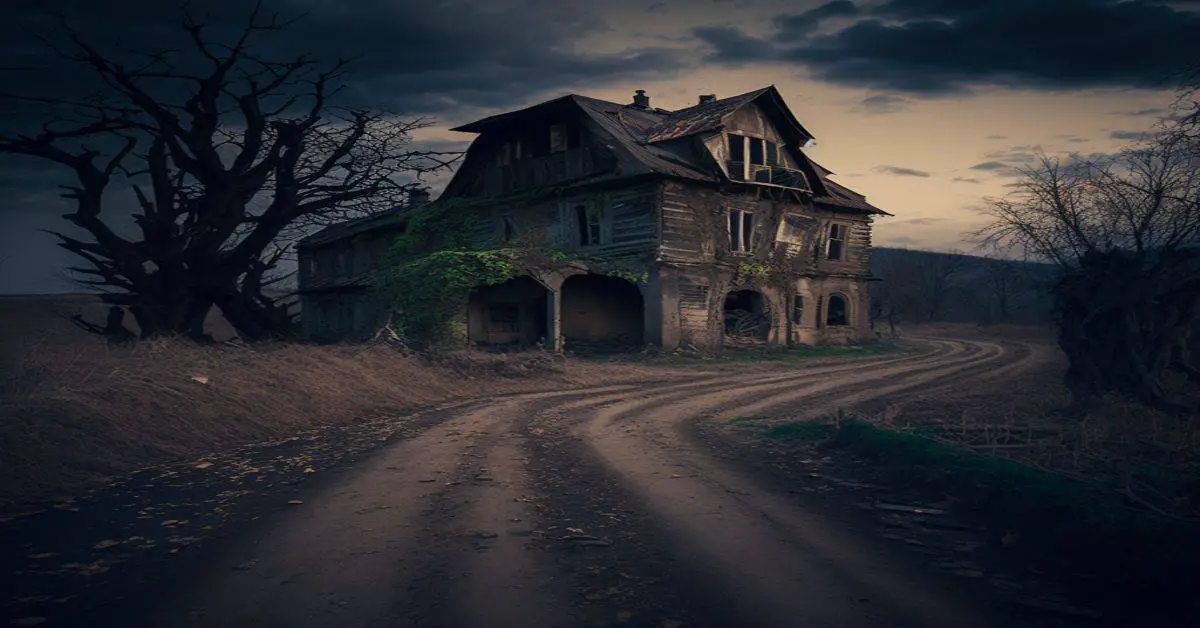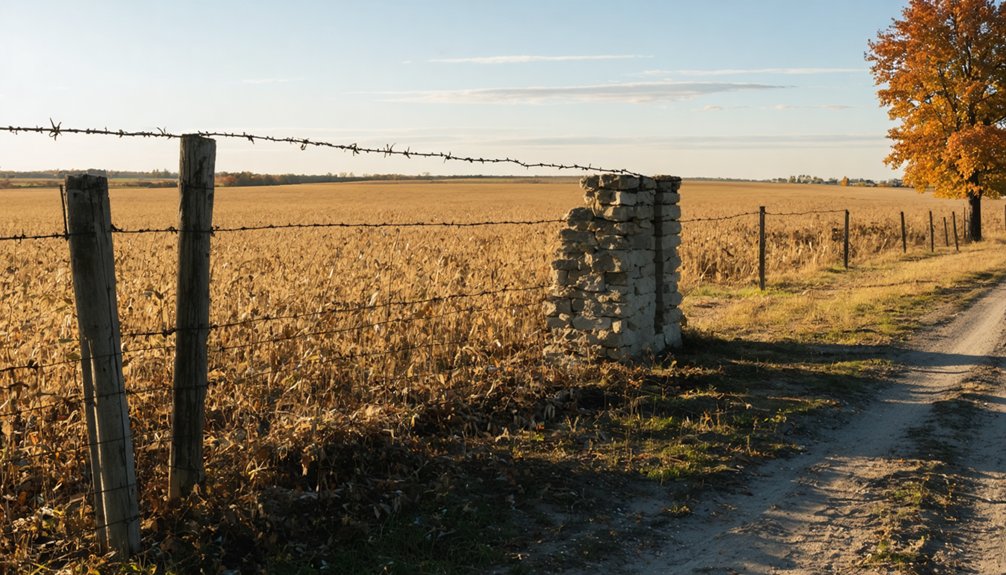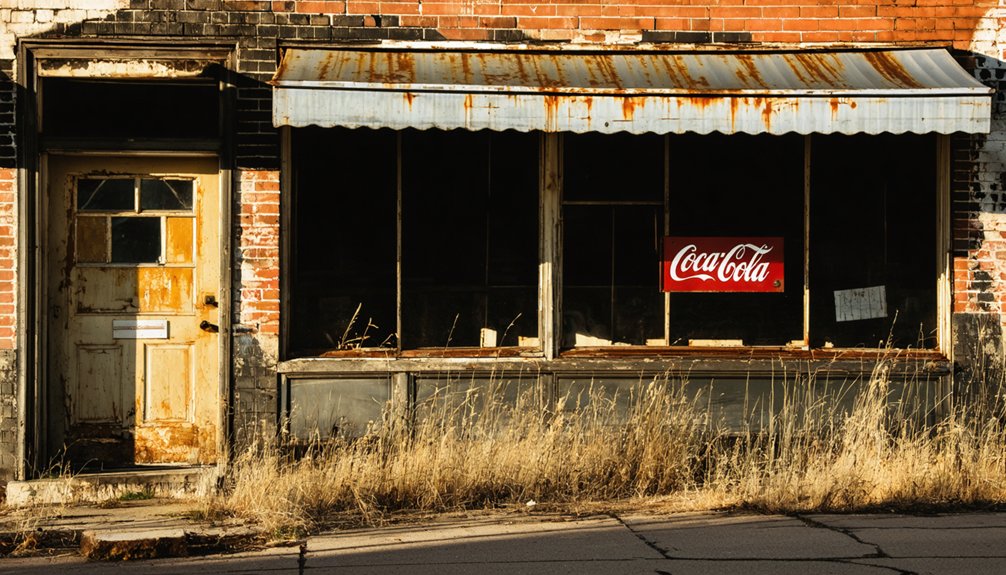You’ll find Mills Prairie two miles southeast of West Salem in Edwards County, Illinois. This once-thriving hamlet, established in the 1820s by Henry I. Mills, featured the area’s first brick house and a bustling post office run by Adam Hedrick. The community flourished through farming and strong social bonds until economic challenges led to its decline. While most physical traces have vanished, the settlement’s rich history shapes Edwards County’s agricultural heritage to this day.
Key Takeaways
- Mills Prairie was established in the 1820s as a prosperous hamlet two miles southeast of West Salem, Illinois.
- The settlement experienced gradual decline throughout the late 19th and early 20th centuries due to economic challenges.
- The community’s post office and local businesses closed as population declined, leading to the area’s abandonment.
- Today, most visible signs of the original settlement have disappeared, with nature reclaiming abandoned buildings and farmland.
- No official markers or preserved structures remain to commemorate Mills Prairie’s historical significance in Edwards County.
Early Settlement and Historical Roots
As settlers pushed westward into Illinois in the early 1820s, Mills Prairie emerged as a pioneering settlement in Edwards County, with Henry I. Mills making the second land entry on September 14, 1822. The area quickly attracted diverse settler experiences, as William Lock and Thomas Mason established themselves in the region that same year. The rural crossroads settlement formed with minimal infrastructure, as most residents focused on agricultural opportunities.
You’ll find the settlement’s cultural diversity reflected in the influence of Moravian settlers, particularly through the McKinney family who moved between Mills Prairie and Indiana.
The community’s growth extended beyond its original boundaries when Enoch Greathouse founded nearby Samsville. Mills demonstrated his commitment to permanent settlement by constructing the area’s first brick house in 1830, setting Mills Prairie apart from typical frontier settlements that relied on log cabin construction. Much like nearby Wanboro in Edwards County, Mills Prairie experienced its own unique challenges in establishing a lasting community presence.
Community Life in Mills Prairie
While Mills Prairie flourished as a small but prosperous hamlet two miles southeast of West Salem, its tight-knit community revolved around agricultural life and civic cooperation.
You’d find families like the Mills and Hedricks working together during planting and harvest seasons, sharing resources and labor to sustain their farming practices.
Community gatherings centered around the local post office, where Adam Hedrick served as postmaster and township treasurer.
Daily life involved farming, animal care, and household duties, with neighbors supporting each other through informal bartering and shared workloads.
Though there weren’t formal cultural institutions, families maintained strong social bonds through agricultural events and home-based gatherings.
The Mills’ brick house, built in 1830, stood as a symbol of the community’s prosperity and collaborative spirit.
The settlement’s location in fertile Edwards County helped establish it as a center of considerable wealth in the region.
As with many abandoned towns, Mills Prairie’s buildings and roads gradually disappeared as residents relocated over time.
The Decline and Transformation
Despite its early promise and agricultural foundation, Mills Prairie experienced a gradual decline through the late 19th and early 20th centuries. The community’s heavy dependence on farming left it vulnerable to economic challenges, including fluctuating crop prices and unpredictable weather patterns.
Unlike neighboring regions that diversified through industrial development, Mills Prairie remained primarily agricultural. Today, the site has become one of McLean County’s significant ghost town locations.
As population decline took hold, you’d have witnessed the closure of essential community institutions, including the post office and local businesses. Much like the town of Buda that saw its population shrink from 1500 residents to less than 500, Mills Prairie faced dramatic demographic changes. The isolated location, far from major markets and transportation routes, further complicated survival.
Eventually, the land transformed as nature reclaimed abandoned buildings, while active farmland absorbed much of the original settlement. Many residents migrated to urban areas seeking better education and employment opportunities, leaving behind a once-thriving community that has now largely returned to its natural state.
Physical Legacy and Modern-Day Remnants
Today’s Mills Prairie bears little resemblance to its former self, with most visible signs of the original settlement having vanished over time.
You’ll find the area located just two miles southeast of West Salem in Edwards County, where fertile agricultural heritage continues to define the landscape.
While no prominent archaeological significance has been documented at the site itself, you’re standing on ground that witnessed early American settlement history, particularly from 1829 when families like the Hedricks first arrived.
Despite the lack of archaeological findings, this land holds the footprints of early American pioneers who settled here in 1829.
The surrounding prairie lands, near Bonpas and Buck Creeks, maintain their agricultural character, though physical remnants of the original community are scarce.
Like the town of Cold Spring, which later became Williamsburg before fading into history, Mills Prairie stands as another example of a once-thriving settlement that time has largely erased.
The area contains rich deposits of valuable shale beds that were once crucial for clay product manufacturing in Edwards County.
While local recognition of Mills Prairie’s historical importance persists, you won’t find official markers or preserved structures marking this once-bustling settlement’s existence.
Historical Impact on Edwards County
As one of Edwards County’s earliest formal settlements, Mills Prairie left an indelible mark on the region’s development after Henry I. Mills made his land entry in 1822. The settlement shaped early demographic shifts through its first post office and brick house, establishing vital infrastructure that attracted more settlers to Edwards County.
- Pioneered agricultural evolution through farming developments that formed the economic foundation of 19th-century Edwards County.
- Fostered community growth via educational institutions, including Mills Prairie High School’s active FFA chapter.
- Influenced county-wide social fabric through cultural organizations and activities.
- Contributed to Edwards County’s administrative framework as an early governmental hub.
Even as Mills Prairie eventually faded into ghost town status, its legacy lives on through the educational and agricultural traditions it established in Edwards County.
Frequently Asked Questions
Were There Any Notable Crimes or Unsolved Mysteries in Mills Prairie?
You’d think a ghost town would have more unsolved murders, but Mills Prairie’s only major mystery was Walter Mayo’s 1878 disappearance. Local records show few other notable criminal activities beyond this case.
What Natural Disasters or Epidemics Affected Mills Prairie’s Population?
You’ll find no direct records of major epidemics, though nearby areas faced disease outbreaks. Regional flood impacts likely affected Mills Prairie, as Mississippi River flooding regularly transformed communities in the American Bottoms.
Did Native American Tribes Have Settlements in the Mills Prairie Area?
While Native American tribes like the Piankashaw used the area for seasonal hunting, you won’t find evidence of permanent tribal settlements specifically at Mills Prairie before white settlement began.
What Was the Average Property Value in Mills Prairie During Its Peak?
In the booming 1850s, you’d find property values were likely $15-50 per acre, reflecting the modest historical economy of rural Illinois. The local property market peaked during the town’s agricultural heyday.
Were There Any Documented Paranormal Activities or Local Legends About Mills Prairie?
You won’t find documented ghost sightings or local folklore about this place – historical records and community archives show no evidence of paranormal activity or supernatural legends in the area.
References
- https://www.youtube.com/watch?v=93k0qtvzkn4&vl=en-US
- https://www.heraldtimesonline.com/story/lifestyle/home-garden/2021/01/15/some-illinois-ghost-towns/43846097/
- https://digitalarchives.aum.edu/sites/default/files/2024-12/Woodham_EdwardsCountyIL.pdf
- https://drloihjournal.blogspot.com/p/lost-towns-of-illinois-series.html
- https://edwards.illinoisgenweb.org/histories/hist1912.htm
- https://illinoishighschoolglorydays.com/2022/03/03/mill-shoals-mills-prairie-high-school-panthers/
- https://en.wikipedia.org/wiki/List_of_ghost_towns_in_Illinois
- http://genealogytrails.com/ill/jefferson/ghostowns.html
- https://history.weld.gov/County-150/Weld-County-Towns/Ghost-Towns-in-Weld-County
- https://drloihjournal.blogspot.com/2022/09/lost-towns-of-illinois-mills-prairie-illinois.html



